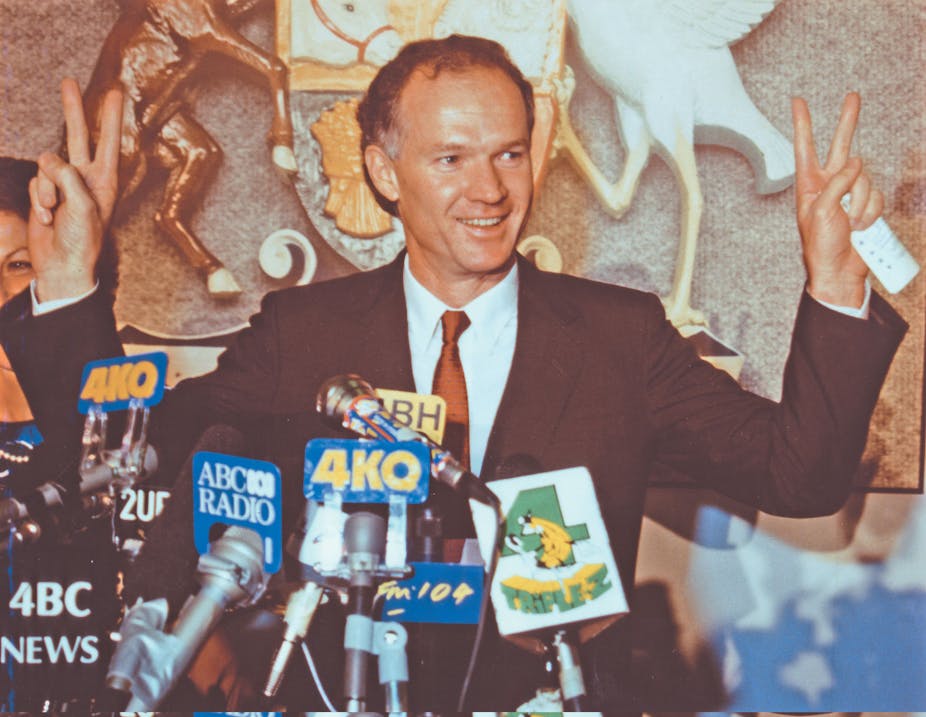Thank you, Queensland. You’ve been good to me. I hope I’ve left you a better place.
So said Wayne Goss as he resigned the role of premier on February 19, 1996. He had served since the election in December 1989 of Queensland’s first Labor government in 32 years.
Though disappointed to lose office, Goss left without rancour, ensuring a smooth transition to the incoming National Party government. He was unchallenged as Labor leader but stood down from that role as well, judging it was time for a new face.
A year later he faced the first of several bouts with a brain tumour. On Monday, aged just 63, Goss succumbed to the illness. Queensland and Australia have lost a political leader of rare integrity.
Goss was born in central Queensland in 1951 and raised in the outer Brisbane suburb of Inala, where he attended high school. His parents were active in community politics and he followed them into the Labor Party after the 1975 dismissal of Gough Whitlam.
While working as an articled clerk, Goss studied law part-time at the University of Queensland. On graduation he worked in the Aboriginal Legal Service before establishing his own law firm with friends.
Goss’ involvement in political activism introduced him to Roisin Hirschfeld, lawyer, social activist and later PhD in history. They made a formidable duo, fierce intellects in a life together.
First through Labor Lawyers and then through the Labor Party, Goss challenged the long-term regime of Queensland premier Joh Bjelke-Peterson, whose government relied on a gerrymandered electoral system to preserve its majority.
Elected first to parliament in 1983, Goss became leader of the parliamentary ALP in March 1988. He moved swiftly to modernise every aspect of the opposition, from policy formulation to campaign technique. His timing was fortuitous – little Labor could throw at the National Party government compared with the revelations of the Fitzgerald Inquiry, which exposed systemic corruption in much of Queensland public life.
Nonetheless, Goss had to contest the 1989 state election on the gerrymandered boundaries. His disciplined and skilful leadership, with policy development led by Kevin Rudd and campaigning by Wayne Swan, secured a substantial majority for the new government. This would be renewed in 1992.
A transformative force in government
A single animating value drove Goss as premier: the need for integrity in government. This required new anti-corruption institutions, an overhaul of electoral laws to entrench “one vote one value”, freedom of information, administrative law reform and major structural changes to the public sector.
The government pursued an ambitious social agenda, too, with a focus on investment in schools, hospitals and new infrastructure. The government responded to burgeoning concern about Queensland’s natural environment with new protections for the Great Barrier Reef and the northern rainforests.
Nonetheless, there were controversies and much reform fatigue. The government was criticised as too focused on economics as it navigated through the recession of 1991.
The High Court Mabo decision on native title highlighted significant tensions between Indigenous communities and mining companies across Queensland. Finding a working compromise proved challenging. Laws on tree-clearing likewise set up conflict between city and country.
A proposed new motorway from Brisbane to the Gold Coast proved electorally disastrous and contributed to near-defeat in the election of June 1995. The government endured for just another eight months before losing its majority in a by-election. Goss resigned.
The obvious next move was to run for federal parliament. But amid a difficult pre-selection process Goss was striken by the first of a series of brain tumours.
During a long process of recovery from surgery, Goss decided to leave politics. He completed an MBA in record time and began the first of many corporate roles, eventually serving as chair of Deloitte and Ausenco among many board appointments.
A lasting legacy of integrity

Goss was a private man, reluctant always to talk about himself or to seek publicity. He was modest and occasionally cautious. In many ways politics was an odd career choice, driven only by a determination to make Queensland a decent and honest state.
When his political career concluded Goss did not look back, though many sought his counsel on issues such as federalism. In later years, he contributed still to this state through leadership of the Queensland Art Gallery, working closely with its director, Doug Hall, first on the Asia-Pacific Triennial of Contemporary Art and then overseeing the magnificent Gallery of Modern Art, a brilliant extension of the Southbank precinct on the Brisbane waterfront.
Goss remained intensely loyal to those who worked with him and proud of the transformation of Queensland public life under his leadership. His reforms have endured: the electoral, ethics and administrative machinery implemented by the Goss government remains largely in place. Given he had only a few short years to overturn decades of corrupt practice, this remains a singular achievement.
Goss indeed left Queensland a better place. His legacy has become part of the accepted fabric of state politics, an enduring legacy for a man of integrity and selflessness. He will be much missed.

